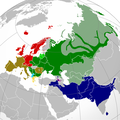Fitxategi:Indo-European branches map.png

Aurreikuspen honen neurria: 599 × 600 pixel. Bestelako bereizmenak: 240 × 240 pixel | 479 × 480 pixel | 767 × 768 pixel | 1.023 × 1.024 pixel | 2.045 × 2.048 pixel | 2.934 × 2.938 pixel.
Bereizmen handikoa ((2.934 × 2.938 pixel, fitxategiaren tamaina: 2,16 MB, MIME mota: image/png))
Fitxategiaren historia
Data/orduan klik egin fitxategiak orduan zuen itxura ikusteko.
| Data/Ordua | Iruditxoa | Neurriak | Erabiltzailea | Iruzkina | |
|---|---|---|---|---|---|
| oraingoa | 05:43, 26 iraila 2022 |  | 2.934 × 2.938 (2,16 MB) | Alexikoua | minor fixes |
| 17:58, 30 martxoa 2022 |  | 2.934 × 2.938 (1,74 MB) | Whoop whoop pull up | Whoops, wrong file! | |
| 17:37, 30 martxoa 2022 |  | 2.048 × 2.048 (980 KB) | Whoop whoop pull up | Misc fixes (Russian minority in Svalbard & Israel, Slovenian in SE Carinthia, Greek in N Epirus, Aromanians/Megleno-Romanians, Swedish essentially extinct in Estonia, etc. | |
| 11:37, 22 abendua 2021 |  | 2.934 × 2.938 (1,74 MB) | Ahmet Q. | Reverted to version as of 19:55, 23 August 2021 (UTC)seek consensus for your changes | |
| 22:40, 25 azaroa 2021 |  | 2.934 × 2.938 (2,16 MB) | Alexikoua | rv elimination of Greek minority in Albania | |
| 21:55, 23 abuztua 2021 |  | 2.934 × 2.938 (1,74 MB) | Ahmet Q. | Rv false edit summary. Overrepresentation of Greeks in Turkey, Albania and Ukraine. Unexplained removal of Romanian in Serbia. Overall deterioration of the original file. Seek consensus for your changes. | |
| 18:16, 7 abuztua 2021 |  | 2.934 × 2.938 (2,16 MB) | Demetrios1993 | Addition of Arbereshe linguistic minority in Sicily. Addition of Serbian, Bosnian, and Gorani linguistic minorities in Kosovo. Addition of Greek linguistic minorities in Italy, Albania, Turkey, and Ukraine. Including some other minor corrections. | |
| 19:00, 19 azaroa 2020 |  | 2.934 × 2.938 (1,74 MB) | Golden | update Armenian | |
| 20:42, 31 martxoa 2018 |  | 1.479 × 1.479 (574 KB) | Maphobbyist | Removed area that exactly corresponds to the non-Indo European Lezgi linguistic area. | |
| 23:37, 6 iraila 2016 |  | 1.479 × 1.479 (620 KB) | Rob984 | Georgia and Azerbaijan aren't majority multilingual. Older generations speak Russian from the Soviet era but now English is taught mainly in place of Russian. More people speak English in Finland, yet that isn't coloured. Also corrections to Celtic are... |
Irudira dakarten loturak
Hurrengo orrialdeek dute fitxategi honetarako lotura:
Fitxategiaren erabilera orokorra
Hurrengo beste wikiek fitxategi hau darabilte:
- ast.wikipedia.org proiektuan duen erabilera
- ban.wikipedia.org proiektuan duen erabilera
- be-tarask.wikipedia.org proiektuan duen erabilera
- be.wikipedia.org proiektuan duen erabilera
- bg.wikipedia.org proiektuan duen erabilera
- cs.wikipedia.org proiektuan duen erabilera
- da.wikipedia.org proiektuan duen erabilera
- de.wikipedia.org proiektuan duen erabilera
- en.wikipedia.org proiektuan duen erabilera
- en.wikiversity.org proiektuan duen erabilera
- es.wikipedia.org proiektuan duen erabilera
- et.wikipedia.org proiektuan duen erabilera
- fa.wikipedia.org proiektuan duen erabilera
- fi.wikipedia.org proiektuan duen erabilera
- frr.wikipedia.org proiektuan duen erabilera
- fr.wikipedia.org proiektuan duen erabilera
- gl.wikipedia.org proiektuan duen erabilera
- gu.wikipedia.org proiektuan duen erabilera
- gv.wikipedia.org proiektuan duen erabilera
- hak.wikipedia.org proiektuan duen erabilera
- he.wikipedia.org proiektuan duen erabilera
- hy.wikipedia.org proiektuan duen erabilera
- hyw.wikipedia.org proiektuan duen erabilera
- ilo.wikipedia.org proiektuan duen erabilera
- incubator.wikimedia.org proiektuan duen erabilera
- io.wikipedia.org proiektuan duen erabilera
- it.wikipedia.org proiektuan duen erabilera
Ikus fitxategi honen erabilpen global gehiago.



